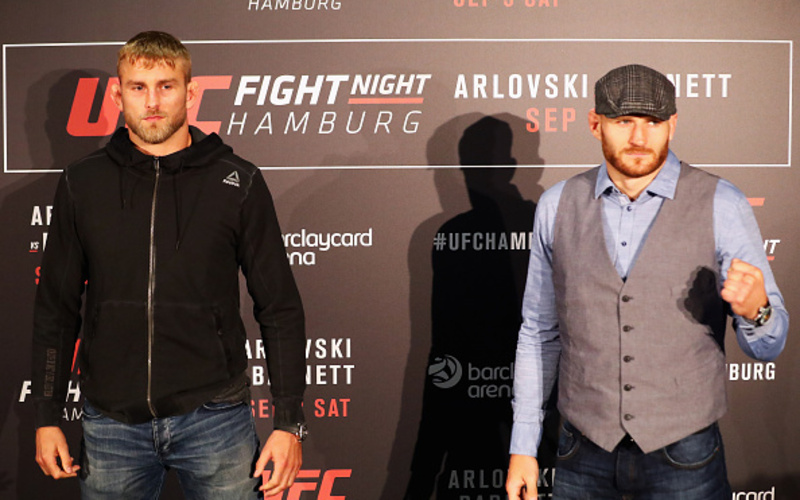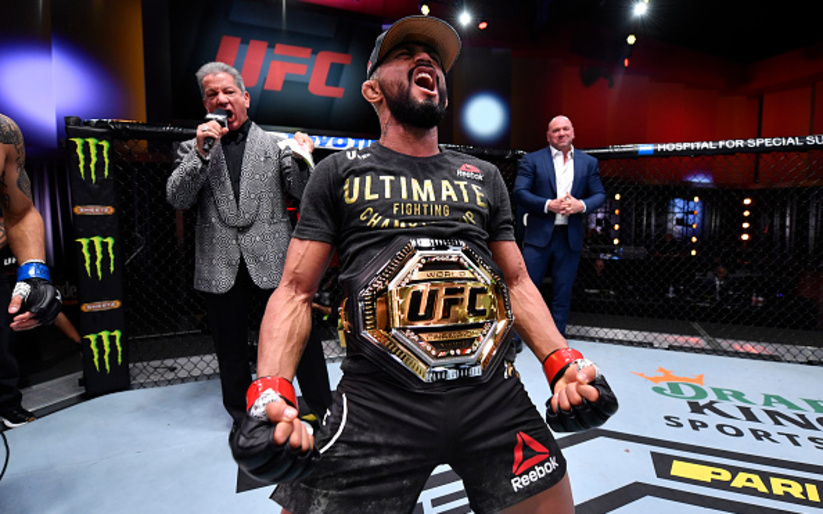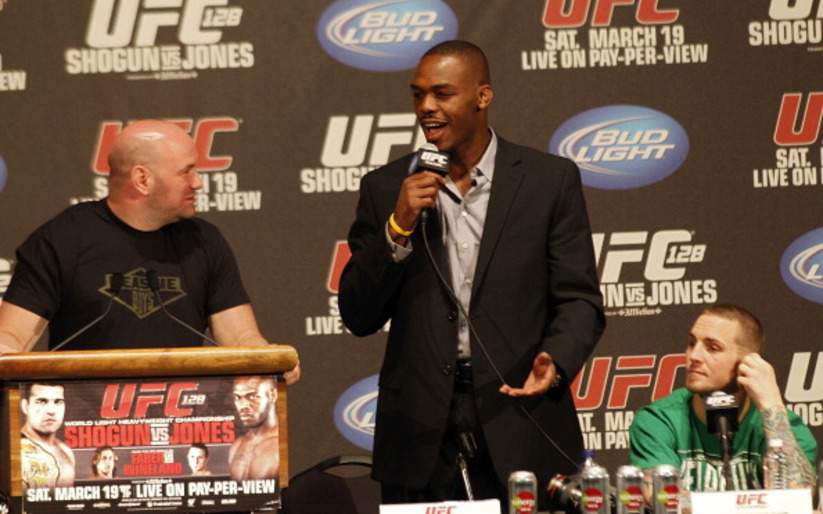This weekends UFC Fight Night: Hamburg is a card that doesn’t seem to be getting much love. It has good fights, recognizable names, and some local talent. But it seems to be missing that must-see element for most fans. For this writer, that element is the co-main event, which showcases the return of Alexander “The Mauler” Gustafsson against Jan Blachowicz.
Gustafsson was nearly a two-time UFC champion. If one judge had scored one of the rounds differently in Gustafsson’s fights with Daniel Cormier and Jon Jones, he would have walked away the victor. The fact that the man dropped a pair of decisions so close, you couldn’t fit a hair between them, to the two best fighters in his division should tell you something about how good he is.
Gustafsson vs. Blachowicz: The Threat Of The Upset
There are many out there who view this fight against the 2-2 Blachowicz as a tune up for the Swede. But I have a saying specifically for these types of situations–hype doesn’t make fights. Styles do. This fight is a clash of styles, and the meeting has merits for both fighters. No fight is ever a guaranteed win, and in this case, the fight is closer than it seems.
Alexander Gustafsson: A Conflict of Ranges
At 6′ 5”, with a 79” reach, Gustafsson is one of the longest and tallest fighters in the 205 pound division. This, matched with his amateur boxing pedigree, would make it seem like Gustafsson is a tremendous outside fighter–someone who uses their length to maintain range and land shots from a distance.
In some regards, he is. Gustafsson has one of the best dipping jabs since B.J. Penn. As he steps in with his jab, Gustafsson takes his head off the center line. This means that if his opponent jabs back, Gustafsson’s jab lands as his opponents misses.
He is also very good at following up his jab. He will tack on a right straight, an uppercut, or a leg kick depending on how his opponent reacts.
The Practicality of Footwork
Gustafsson’s light feet have been well documented. He circles the cage dozens of times a round, and he changes direction very well. This has kept him out of danger against great dirty boxers like Jon Jones and Daniel Cormier, as they were unable to walk him to the fence.
Kicks: Not just for Kickers
While his legs are longer than even Jon Jones’, Gustafsson doesn’t kick that well. What he does do is kick often, and in some cases that is more important. He is happy to kick with great kickers like Jon Jones, or great wrestlers like Cormier, or powerful punchers like Anthony “Rumble” Johnson. This has gotten him in trouble with all three, most famously against Rumble, but it serves to prevent him from being stuck on the end of someone like Jones’ kicking range and be unable to use his hands. Liike Nate Diaz recently against Conor McGregor.
With all these tools, one would assume that Gustafsson would indeed be a great fit as an outside fighter. The truth however, is that Gustafsson likes to give his range away like it’s about to pass its sell by date. That is not to say that Gustafsson does not make use of his long physique. He simply chooses to do so in a way that closes the range rather than maintains it.
An Unusual Tool
The one technique you will see from Gustafsson above all else is his right uppercut. This punch is not that unusual, Daniel Cormier loves it from the clinch, but what is unusual is how many situations Gustafsson tries to fit it in to. He throws it as on the lead, as a counter, in combination, as a single shot, from close range, in the open and in the clinch. Think of a position on the feet, chances are Gustafsson has uppercutted from there.
The reason you don’t normally see this is that a right uppercut is a pretty risky punch. It takes a long time to wind up. You need to drop your hand and bring it back up in a U shaped motion, then return to guard. Because you need to keep your arm almost completely folded to hit with the knuckles, the range is extremely limited. That is not to mention that in order to be effective, an opponents head would have to be level with your shoulder to generate proper power. Any higher up and the punch loses a lot of its starch. Gustafsson gets away with it because of his reach and height.
Secondary Weapons:
The right uppercut may be the staple of his game, but Gustafsson is far from a one trick pony. While many would look at this fight and expect a stand up war, the fact is Gustafsson has taken down every opponent who has wanted to strike with him. James Te Huna, Mauricio Rua, Cyrille Diabate, Jimmie Manuwa, Jon Jones and Daniel Cormier all came in expecting a striking match and all found themselves underneath Gustafsson at some point in their bouts. His ability to play with his opponents expectations is one of Gustafsson’s best attributes. By taking his opponent down early, he can plant the idea in their head and begin to fake takedowns in to jabs, right hand leads, and uppercuts.
His knee’s from the clinch are also a large part of his game. Because of his height, his knee strikes land in places where guys normally think they are safe. He has caught more than a few people with this, most famously against Manuwa.
That is Gustafsson in a nutshell. His ability to fight from the outside is great, but some of his best techniques, namely the right uppercut, the knees, and his takedowns, all rely on him closing the distance, and once there he is not usually that effective. Height and reach are advantages at range, but up close a higher center of gravity makes you easier to off balance, and longer arms have wider arcs to travel on before they land. Someone of Gustafsson’s size and abilities should be looking to maintain his range, but out of necessity he finds himself at close range more often than he should.
Jan Blachowicz: A One Sided Threat
Blachowicz to me one of the most unusual fighters than I can ever remember watching. What is unusual is that his offence comes almost entirely off his left side. Right handed pugilists are a dime a dozen in MMA. But a technical striker who almost refuses to use his right side is just plain weird.
Blachowicz makes use of the jab and the lead leg kick predominantly in his offence. If pressured, he will circle almost entirely to his left, then pop stern jabs in to his opponents face as they step after him.
Baiting the trap
He will vary his jab with a lead left uppercut. Unlike Gustafsson’s right, Blachowicz uses this almost exclusively as a counter. He sets it up so as his opponent ducks what they think is a jab, they duck in to the uppercut. He will occasionally throw it from the southpaw stance but the idea is the same, get them ducking, then meet them halfway.
Because Gustafsson likes to dip his head almost exclusively to his right, this could be a big factor in the fight. If he commits to a jab off with Gustafsson, Blachowicz will get out-jabbed every time. But a left uppercut as Gustafsson slips could be a great way to catch him coming in.
Defensive Savvy, Or Unnecessary Risk?
Blachowicz has a few habits that can be taken two ways. On one hand, they work to keep him out of danger. On the other, they are extremely risky strategies.
One of these tendencies is an unusual habit to see from a high level striker: when punches come his way, he pulls back at the waist and leans. This takes him out of the range of most shots, and more importantly makes uppercuts very ineffective. You can’t effectively uppercut someone whose head is behind their chest. However as most will remember thanks to Anderson Silva and Chris Weidman, taking your head out of position without having your feet under you is a great way to get knocked out by a follow up shot.
From the ground, Blachowicz has a pretty active guard for a light heavyweight. However he is far too comfortable on the bottom. He will look to tie up the arms and try and ride out a bad position, rather than scramble to his feet. This inactivity is also present in the clinch, he simply doesn’t disengage even when he should. These habits are what saw Blachowicz drop decisions to Manuwa and Corey Anderson. They could be exploited by Gustafsson, who likes to surprise strikers with a round of wrestling to start the fight.
The Dangers of a Power Kicker
What really makes Blachowicz dangerous is his left kick. When allowed the center of the cage, he will throw it out as a switch kick, or go full on southpaw and throw it as a powerful rear leg kick. This is the only technique he uses from the southpaw stance. Every time he changes stance, the round kick follows. But he keeps landing it on people, and the results speak for themselves.
This is especially important against Gustafsson. One of the biggest flaws in Gustafsson’s game is that while he circles out constantly, he very rarely retreats. This means he will look to take a kick rather than avoid it. Coupled with his tendency to duck his head, this could lead him in to trouble against a powerful kicker like Blachowicz.
Final Thoughts:
Many people are acting like the winner of this fight is already decided. That is not the case. The fight will be decided by who controls the center of the octagon.
If Gustafsson holds the center, his dipping jab and follow ups could well catch Blachowicz leaning away. Blachowicz’s tendency to hang around in the clinch would be ill-advised against Gustafsson. His lack of urgency off his back could also see him drop rounds and lose a decision.
If Blachowicz holds the center however, his round kicks are the perfect weapon against the Swede. He could easily encourage Gustafsson to circle in to his kicks. In that situation his left hand heavy attack is perfect to capitalize on Gustafsson’s long lead uppercuts.
This fight is either mans to win or lose. Both have aspects of their game they can use to their advantage. Both have habits that will get them in to trouble. Even if Gustafsson wins this match, it won’t be because he was expected too. It will be because he earned it. That is the beauty of MMA. Even if all the odds are stacked against someone, it all comes down to how you fight on the night. Some of the best guys in the world have lost fights they shouldn’t have due to bad performances. After all, a gimme fight is still a fight, and any fight can be lost.



